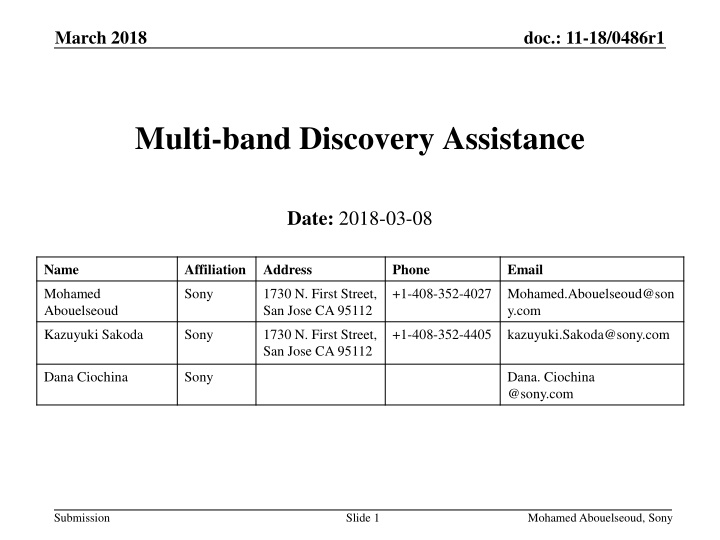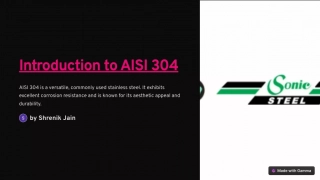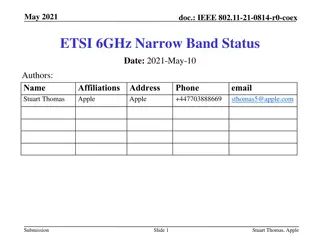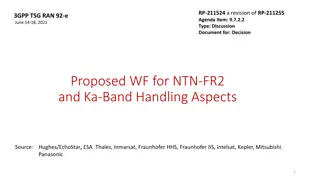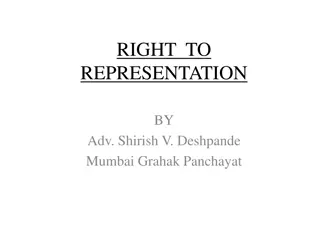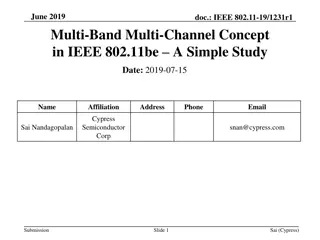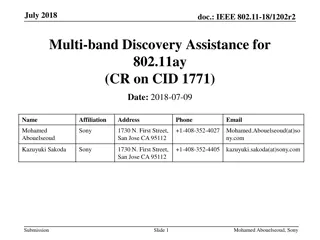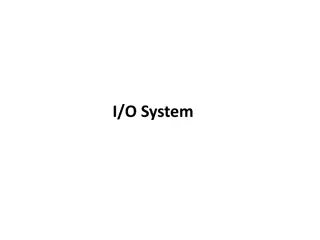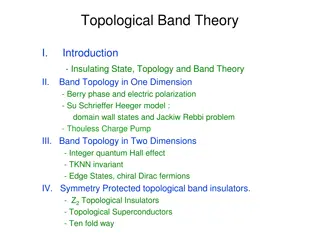Multi-band Discovery Assistance for Consumer Devices
Robustness and latency are critical for consumer devices. This contribution proposes a solution utilizing multi-band capability to enable TDD mode without human triggering, focusing on efficient beacon transmission and discovery assistance in both TDD and non-TDD modes for optimal performance and reduced overhead.
Download Presentation

Please find below an Image/Link to download the presentation.
The content on the website is provided AS IS for your information and personal use only. It may not be sold, licensed, or shared on other websites without obtaining consent from the author.If you encounter any issues during the download, it is possible that the publisher has removed the file from their server.
You are allowed to download the files provided on this website for personal or commercial use, subject to the condition that they are used lawfully. All files are the property of their respective owners.
The content on the website is provided AS IS for your information and personal use only. It may not be sold, licensed, or shared on other websites without obtaining consent from the author.
E N D
Presentation Transcript
March 2018 doc.: 11-18/0486r1 Multi-band Discovery Assistance Date: 2018-03-08 Name Affiliation Address Phone Email Mohamed Abouelseoud Sony 1730 N. First Street, San Jose CA 95112 +1-408-352-4027 Mohamed.Abouelseoud@son y.com Kazuyuki Sakoda Sony 1730 N. First Street, San Jose CA 95112 +1-408-352-4405 kazuyuki.Sakoda@sony.com Dana Ciochina Sony Dana. Ciochina @sony.com Submission Slide 1 Mohamed Abouelseoud, Sony
March 2018 doc.: 11-18/0486r1 Agenda Overview Problem Description Proposed Solution Conclusion Submission Slide 2 Mohamed Abouelseoud, Sony
March 2018 doc.: 11-18/0486r1 Overview Robustness and latency are critical for consumer devices use cases In [1], TDD mode is presented as a solution: (a) TDD is designed for distribution network (b) Reduce overhead allowing less impact on latency mmW access link mmW distribution link ` mmW DN To solve (b), in [2], we proposed the use of the multi-band capability to enable TDD for consumer devices without relying on human triggering This contribution presents details on a proposed solution to use the multi-band operation defined in the standard for triggering mmW devices discovery Submission Slide 3 Mohamed Abouelseoud, Sony
March 2018 doc.: 11-18/0486r1 Problem Description Sweeping beacons all the time consumes channel time and blocks data transmission Partial beacon sweeping can reduce the overhead however it can affect discoverability Full sweep beacon transmission should only happen whenever its necessary (i.e. a new STA is introduced) After the new STA is beamformed, beacon transmission should switch back to minimum Submission Slide 4 Mohamed Abouelseoud, Sony
March 2018 doc.: 11-18/0486r1 Discovery for TDD mode Continues for Discovery Assistance Window Length Beamforming frames Beamforming window 0 Beamforming window 1 60 GHz - Initiator 60GHz Responder (new STA) Ideal beam combination found. Time sync and frame periodicity acquired Responder sweeping RX beams New node is on On demand sweeping is a built-in feature in TDD mode However, TDD mode as presented in [3] assumes manual triggering of the unicast beamforming frames. A proper discovery trigger signaling is needed to enable the use of TDD mode for consumer devices Submission Slide 5 Mohamed Abouelseoud, Sony
March 2018 doc.: 11-18/0486r1 Discovery for non-TDD mode Discovery assistance window for helping the new STA Small BHI Beacons sweeping Small BHI 60GHz -AP 60GHz new STA New STA scanning New node is on Latency reduction can also be achieved through non-TDD mode Tools already provided in the standard to reduce beacon transmission periodicity(partial sweeping), ABFT period optional, ATI optional Reducing BHI to minimal affects discoverability A discovery trigger signal is needed to enable the full beacon sweep only whenever it is needed and keep it minimum otherwise Submission Slide 6 Mohamed Abouelseoud, Sony
March 2018 doc.: 11-18/0486r1 Proposed Solution: Discovery Assistance Flow Example Indication is sent on Sub- 6GHz of multi-band capability and discovery assistance capability Request and response frames are exchanged on sub-6GHz to request mmW discovery assistance and accept/reject the mmW discovery assistance If discovery assistance is accepted, mmW beamforming frames or beacons are sent to the new multi-band STA New Multi-band capable device AP Multi-band capable device Sub-6GHz MLME (AP) mmW MLME Sub-6GHz MLME mmW MLME Beacon stating discovery assistance capability Connection setup / RSNA setup Multi-band Discovery Assistant Request frame Multi-band Discovery Assistant Response frame Start transmitting beamforming frames/ beacons in all directions for Discovery Assistance Window Length Connection setup Submission Slide 7 Mohamed Abouelseoud, Sony
March 2018 doc.: 11-18/0486r1 Discovery Assistance Capability Announcement on the Sub-6GHz Band A Multi-band capable device advertises the Multi-band capability by including the Multi-band element in the Beacon and Probe Response frames 1-bit is needed in the Multi-band element to indicate that STA supports discovery assistance for the BSS identified by the BSSID field on the defined frequency band and channel Propose to use 1 bit out of the 3 reserved bits in the Multi-band Control field B0 B2 B3 B4 B5 B6 B7 Discovery Assistance Enabled STA MAC Address Present Pairwise Cipher Suite Present STA Role Reserved 3 1 1 1 2 Bits: Multi-band element Submission Slide 8 Mohamed Abouelseoud, Sony
March 2018 doc.: 11-18/0486r1 Multi-band Discovery Assistance Request frame Propose a new Action frame of category FST Action After receiving the multi-band element (from a Beacon or a Probe Response frame for example) on the sub-6GHz band, new STA is aware of the Multi-band capability of peer STA and the discovery assistance offering on the other band (60GHz) New STA sends a Multi-band Discovery Assistant Request frame on the sub-6GHz band The frame carries the following DMG Capabilities on the 60GHz band STA MAC address on the 60GHz band Scanning mode requested on the 60GHz band Operating frequency/channel on the 60GHz band BSS information on the 60GHz if available Submission Slide 9 Mohamed Abouelseoud, Sony
March 2018 doc.: 11-18/0486r1 Multi-band Discovery Assistance Request frame format FST Action DMG Multi-band Discovery Assistance Request IE Category Capabilities IE B0 B1 B2 B4 B7 BSS Present Scanning Mode Reserved Information Bits: 1 2 5 Submission Slide 10 Mohamed Abouelseoud, Sony
March 2018 doc.: 11-18/0486r1 Multi-band Discovery Assistance Response frame Propose a new Action frame of category FST Action Peer STA receives the Multi-band Discovery Assistance Request frame on the Sub-6GHz band and generates Multi-band Discovery Assistance Response Frame Peer STA sends Multi-band Discovery Assistant Response frame on the Sub-6GHz band The frame carries the following Discovery assistant response (accept/reject) STA MAC address on other band (60GHz) Discovery Assistant Window Length on the 60GHz band BSS information on the 60GHz Scanning mode on 60GHz Submission Slide 11 Mohamed Abouelseoud, Sony
March 2018 doc.: 11-18/0486r1 Multi-band Discovery Assistance Response frame format FST Action Multi-band Discovery Assistance Response IE Category B4 B5 B0 B1 B2 B3 B6 B7 Scanning Mode Discovery Assistance Response Map Reserved Reserved Bits: 2 2 4 2 Submission Slide 12 Mohamed Abouelseoud, Sony
March 2018 doc.: 11-18/0486r1 TDD mode 60 GHz Discovery Assistant Peer STA is informed about the new node on the 60 GHz channel and its capabilities Peer STA starts sending BF frames or more beacons on the 60 GHz channel New STA is informed about peer STA on the 60 GHz channel and its capabilities New STA starts listening for TDD BF frames, beacons on the 60 GHz channel STA capability is used by peer STA to estimate the periodicity and rate of sending BF frames , beacons or switching the receive beams Beacon indicating Multi-band with discovery assistant enabled Sub-6GHz - AP Beacon received MB Discovery assistant response Sub-6Ghz new STA Continues for Discovery Assistance Window Length Beamforming frames MB Discovery assistant request Beamforming window 0 Beamforming window 1 60 GHz - Initiator 60GHz Responder (new STA) Ideal beam combination found. Time sync and frame periodicity acquired Responder sweeping RX beams SME starts Discovery at mmW band for TDD mode Submission Slide 13 Mohamed Abouelseoud, Sony
March 2018 doc.: 11-18/0486r1 Non-TDD mode 60GHz Discovery Assistant Same procedure can be used for non-TDD mode operation - Beacon transmission on 60GHz is reduced - Announce MB Discovery Assistant on sub-6GHz - Once Discovery Assistant requested and accepted on sub-6GHz, send more beacon in all directions on 60GHz band Beacon indicating Multi-band with discovery assistant enabled Sub-6GHz - AP MB Discovery assistant response Beacon received Sub-6GHz new STA MB Discovery assistant request Discovery Assistance Window Length Small BHI Beacons sweeping Small BHI 60GHz -AP 60GHz new STA New STA scanning SME starts Discovery at mmW band for non TDD mode Submission Slide 14 Mohamed Abouelseoud, Sony
March 2018 doc.: 11-18/0486r1 Multi-band Discovery Assistance Procedure New Multi-band capable device Multi-band capable device Communication MLME MLME-SCAN.request Discovery MLME Discovery MLME Communication MLME SME SME Node discovery on the discovery band MLME-SCAN.confirm Possible connection setup MLME-MB-DISCOVERY- ASSIST.request Multi-band Discovery Assistance Request frame MLME-MB-DISCOVERY- ASSIST.indication MLME-MB-DISCOVERY- ASSIST.response Multi-band Discovery Assistance Response frame MLME-MB-DISCOVERY- ASSIST.confirm MLME-START-DMG- DISCOVERY- ASSISTANCE.request MLME- SCAN.request Device discovery on the communication band MLME-START-DMG- DISCOVERY- ASSISTANCE.confirm MLME- SCAN.confirm Submission Slide 15 Mohamed Abouelseoud, Sony
March 2018 doc.: 11-18/0486r1 Conclusion Discovery Assistance procedure is proposed for DMG multi-band capable devices to trigger mmW discovery and mmW beamforming Proposed modification to the Multi-band element 2 new elements for requesting discovery assistance and responding to discovery assistance request are proposed 2 new Action frames for requesting discovery assistance and responding to discovery assistance request are proposed Submission Slide 16 Mohamed Abouelseoud, Sony
March 2018 doc.: 11-18/0486r1 References [1] IEEE 802.11-18/194r1, Distribution network use case for consumer devices , Kazuyuki Sakoda, et.al. [2] IEEE 802.11-18/199r2, MMWave Distribution Network Discovery , Mohamed Abouelseoud, et.al. [3] IEEE 802.11-17/1321r0 Features for mmW Distribution Network Use Case , Djordje Tujkovic, et.al. Submission Slide 17 Mohamed Abouelseoud, Sony
March 2018 doc.: 11-18/0486r1 Jan 2018 Contribution[2] Recap Jan 2018 straw polls Do you think additional signaling for discovery triggering is needed for the TDD mode described in [3] to support consumer devices? Yes (16), No(3), Need more information (11), Don t care (0) Do you think the use of Multi-Band operation would be feasible approach for off-60GHz discovery signaling? Yes (20), No (0), Need more information (8), Don t care (0) Which of the options described in [2] would you prefer? Option 1 (0), Option 2 (6), Need more information(14), Don t care(0) Submission Slide 18 Mohamed Abouelseoud, Sony
March 2018 doc.: 11-18/0486r1 Device Provisioning Protocol (DPP) New STA AP Wi-Fi Alliance defined protocol Provides a secure method for on- and off-boarding devices with limited user interface on a Wi-Fi network. AP discovery and STA scanning are beyond what DPP is offering DPP Scanning Authentication Association Submission Slide 19 Mohamed Abouelseoud, Sony
